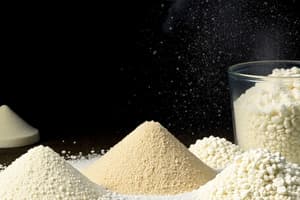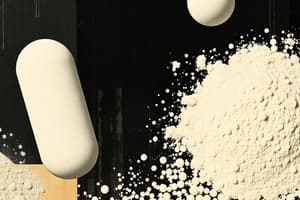Podcast
Questions and Answers
Topical powders are used for cutaneous ______.
Topical powders are used for cutaneous ______.
application
Dusting powders are normally dispensed in glass or metal containers with a ______ lid.
Dusting powders are normally dispensed in glass or metal containers with a ______ lid.
perforated
Canesten Powder contains clotrimazole and is used as an ______ agent.
Canesten Powder contains clotrimazole and is used as an ______ agent.
antifungal
A pharmaceutical powder is a mixture of finely divided drugs and/or chemicals in ______ form meant for internal or external use.
A pharmaceutical powder is a mixture of finely divided drugs and/or chemicals in ______ form meant for internal or external use.
The excipients used in powders must possess good ______ properties.
The excipients used in powders must possess good ______ properties.
Bulk powders, such as antacids, require the patient to take the dose by mixing it with ______.
Bulk powders, such as antacids, require the patient to take the dose by mixing it with ______.
Granules may contain one or more ______, with or without other ingredients.
Granules may contain one or more ______, with or without other ingredients.
Medicated powders for therapeutic effect have ______ applications due to their limited uses.
Medicated powders for therapeutic effect have ______ applications due to their limited uses.
The usual size ranges of granules are in the range of 4–12 ______ sieve.
The usual size ranges of granules are in the range of 4–12 ______ sieve.
Before their use in preparation, solid materials are characterized including morphology, purity, and ______.
Before their use in preparation, solid materials are characterized including morphology, purity, and ______.
The mesh size is the number of openings per linear ______.
The mesh size is the number of openings per linear ______.
USP uses terms like very coarse, coarse, moderately coarse, fine, and very ______.
USP uses terms like very coarse, coarse, moderately coarse, fine, and very ______.
Sieves can be referred to either by their aperture size or by their ______ size.
Sieves can be referred to either by their aperture size or by their ______ size.
Particle size can influence the rate of drug ______ and its bioavailability.
Particle size can influence the rate of drug ______ and its bioavailability.
Suspensibility of particles is important for uniform ______ in a liquid vehicle.
Suspensibility of particles is important for uniform ______ in a liquid vehicle.
The ______ of particles intended for inhalation is crucial for deep deposition in the respiratory tract.
The ______ of particles intended for inhalation is crucial for deep deposition in the respiratory tract.
Oral powders may be swallowed directly or mixed with a suitable ______.
Oral powders may be swallowed directly or mixed with a suitable ______.
Inhalation powders are used effectively for treating ______ and chronic obstructive pulmonary disease.
Inhalation powders are used effectively for treating ______ and chronic obstructive pulmonary disease.
Nasal powders are designed for administration into the nasal ______.
Nasal powders are designed for administration into the nasal ______.
Oral powders may contain one or more active substances with or without ______.
Oral powders may contain one or more active substances with or without ______.
Nasal powders may include an inert ingredient, such as ______, to liberate the drug.
Nasal powders may include an inert ingredient, such as ______, to liberate the drug.
Study Notes
Powders
- Powders are finely divided drugs or chemicals in dry form for internal or external use.
- They are one of the oldest dosage forms.
Granules
- Granules are aggregates of powder particles containing APIs and other ingredients.
- They can be used for medicinal value or pharmaceutical purposes, like tablet making.
- The usual granule size is 4-12 # sieve.
Uses of Powders
- Medicated powders are used for therapeutic effect.
- Powders are extensively used in the preparation of other dosage forms:
- Solid dosage forms like tablets and capsules.
- Liquid dosage forms by dissolving or suspending in solvents.
- Semisolid bases for medicated ointments and creams.
Characterization of Powders
- Before use, solid materials are characterized for:
- Morphology
- Purity
- Solubility
- Flowability
- Stability
- Particle size
- Uniformity
- Compatibility with other formulation components
Particle Size
- Uniform particle size is crucial for blending.
- USP uses terms like very coarse, coarse, moderately coarse, fine, and very fine.
- Particle size is related to the portion of powder passing through sieve series.
- Sieves are referred to by their aperture size or mesh size.
- Particle size influences:
- Dissolution rate (micronization increases bioavailability).
- Suspendability of undissolved particles (e.g., 0.5 to 10 µm for fine dispersions).
- Uniform distribution of drug substance in powder mixtures or solid dosage forms.
- Penetrability of inhaled particles (e.g., 1-5 µm for deep respiratory tract deposition).
- Grittiness in dermal ointments, creams, and ophthalmic preparations (e.g., fine powders may be 50 -100 µm in size).
Classification of Powders/Granules by Route of Administration
- Oral powders: Administered with water or other liquids, or directly swallowed.
- Inhalation powders: Used for lung treatment via inhalation device.
- Nasal powders: Delivered to the nasal cavity with a suitable device.
- Topical powders: Applied to skin or mucous membranes.
- Dusting powders: Used for external application with good flow properties.
Powder Excipients
- Excipients must have:
- Narrow particle size distribution
- Good flowability
- Good pressure-hardness profile (for tablet formulation)
- High capacity
- High bulk density
Bulk Density
- Bulk density is a measure of the volume occupied by a certain weight of diluent.
Studying That Suits You
Use AI to generate personalized quizzes and flashcards to suit your learning preferences.
Related Documents
Description
This quiz covers the essential concepts of pharmaceutical powders and granules, including their definitions, uses, and characterization. Understand their roles in drug formulation and the relevance of particle size and purity in pharmaceutical applications.




